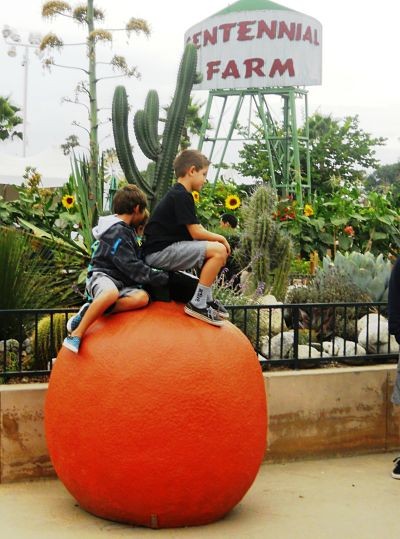
Amid the funnel cakes, the Texas-sized corn dogs, the $11 beers, the garish carnival rides and Hall & OatEs performances and the swap meet called the Parade of Products and all the reasons why the Orange County Fair is dismissed by the hipstergentsia for catering to the consumer-addled and high-calorie sensibilities of Middle America, there is something to keep in mind. The fair, as part of the state's 32nd Agricultural District, remains firmly committed to the reason why county fairs began in the early 1800s: to promote agriculture. Whether it's the livestock judging and exhibits to the expansive Centennial Farm, the Fair offers residents of one of the most most urbanized counties in the country a chance to see their Big Mac's aren't farted out by cows as tiny, seasoned patties, and that pizza doesn't grow on trees. Those are just two of the six reasons how the Fair still has its roots plunged deeply in the soil of old-school fairs….
]
1. MEAT!
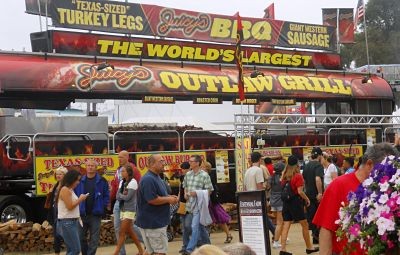
OK, no one's really sure what people at the first OC Fair, in 1890, ate. But chances are good that there was a great deal of barbecued and fried meat. And it's no different today. The sheer amount of meaty choices–along with the portion sizes and cost–is staggering. Name it, and it's a safe bet some vendor is shilling it out, from fried frog legs and beef brisket, to pulled pork and bacon slathered in chocolate. Perhaps the best words that capture this carnivorous phantasmagoria come from the recording that loops every couple of minutes at one of the largest vendors at the Fair, Juicy's Outlaw Grill. (Think Texas-hued drawl)…
“If your belly button is gnawing at your back bone, come on in to Juicy's. We got what'll cure you. The best food in the country is right here. Get your giant western sausages. We got Texas-sized smoked turkey legs. The tastiest half-pound hamburgers around. And don't forget our mountains of curly fries. We also have jumbo corn dogs. And to quench your thirst, we have lemonade, lemonade, lemonade. Come on in, folks. You won't be hungry after leaving…Juicy's.
2. Actual Crops
Centennial Farm, a small garden first proposed sometime in the late 1980s by the one person who has done more to promote farming and livestock at the Fair than anyone, Jim Bailey, has evolved into a three-acre working farm. An impressive number of crops, from Tabasco and ghost peppers, to corn and sunflowers, are laid out in rows with sign identifiers, so never again will you have to ask what a potato looks like growing in in the ground. There are interesting facts and exhibits scattered throughout the farm about the crops and the animals housed in the barns, and while it's easy to miss if your Fair odyssey is focused on rides and eats, it's an impressive tract of land.
But, people, don't feed the animals and DON'T PICK THOSE FUCKING CROPS! It's bad form and also the best thing about the farm, next to giving urbanites the opportunity to see real food in real ground really growing, is that most of the fruits and vegetables are donated to a local food bank.
3. Actual Animals
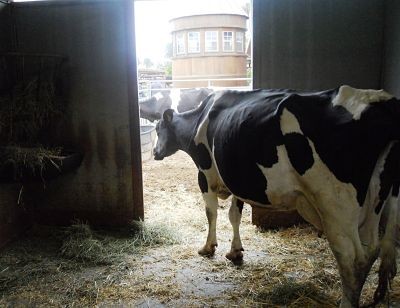
The livestock area, in the northeast part of the Fair, may not generate the money–or the nausea–of the food and carnival, but this is where the real heart beats. Hundreds of local 4-H and FFA members from across the county bring their cows, sheep, turkeys, pigs, goats and rabbits to the fair each year to market with most auctioned off. (Yes, while there are occasionally good-hearted folk, like parents, who bid in order to give the kids their animals back, most of these fine specimens are headed to a slaughterhouse.)
After the livestock auction, which was held July 21 this year, adult farmers bring their animals for judging. The last week, the livestock area mostly contains exhibits, like a blacksmith and oxen displays, so if you go later in the Fair's run, your best bet to see animals are in Centennial Farm. And if the aroma offends, just remember this Estonian proverb, laid out on a sign in the Livestock Area:
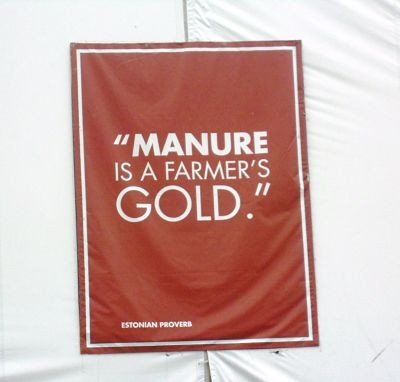
[
4. Crazy Competitions
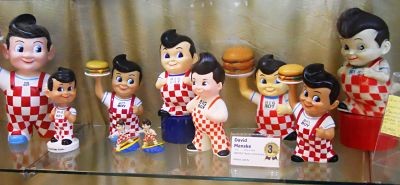
A staple of county fairs since their inception, the juried competitions feature a dazzling amount of professionals and amateurs vying for one of them damn ribbons. From arts and crafts (check out the mind-blowing woodwork on display this year) and food/beer/wine to painting and photographs, the entries are housed in buildings that many fairgoers may skip, but they shouldn't. Roaming through them is both informative (who doesn't want to know the history of chocolate molds?)as well as an air-conditioned retreat from the maddening crowd swirling about outside.
My favorites are the collections, which are now housed in the Silo Building at Centennial Farm. While there are no reasons offered, usually, why people collect such a wild array of things–from Bob's Big Boy dolls and antique tape measure to this year's best of show, an assortment of hood ornaments from antique cars collected by Dennis Mitosinka–the insatiable thirst of humans to accumulate and collate is on full display.
5. Snake-Oil Salesmen

OK, maybe this is more carnival than a fair, but just check out the rap delivered by the people in the Parade of Products selling everything from waterless cookware to–AS SEEN ON TV–expandable hoses, you'll see the trade of hucksterism remains alive and well.
6. Con Men
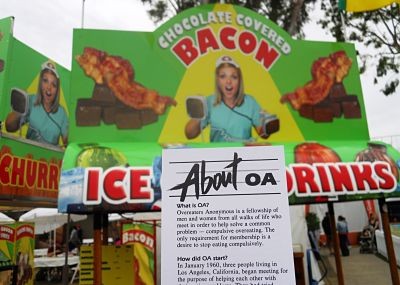
Not sure when carnival midways were introduced to fairs, but they've probably been around a long time. The carnival workers at the Fair today are a far cry from the blinged-up, burned-out carnies who once staffed its gaming area. Everyone appears young, fresh-faced and nary a tattoo is in site. But, their stock-in-trade remains the same: to convince suckers to drop their dough on games that, obviously, can be won, but are set up in a way that, while technically legal, still make it extremely difficult (and costly) to walk away with one of them gargantuan Scooby Doos.
Follow OC Weekly on Twitter @ocweekly or on Facebook!
Joel Beers has written about theater and other stuff for this infernal rag since its very first issue in, when was that again???

